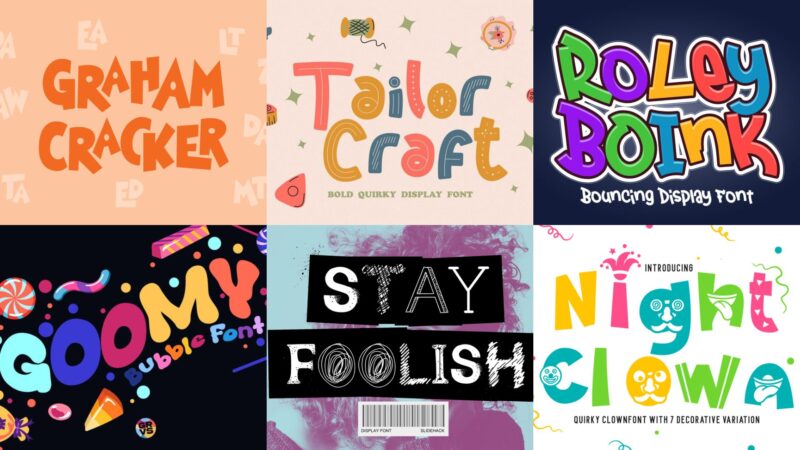In this article:
- The Silliest Fonts That'll Have You Rolling in 2026
- What Makes a Font Delightfully Silly?
- Where Silly Fonts Shine Brightest
- When to Avoid Silly Fonts (And Why)
- How to Choose the Perfect Silly Font
- The Psychology Behind Silly Typography
- Creative Alternatives to Traditional Silly Fonts
- Common Silly Font Questions Answered
- Making Your Mark with Silly Typography
As graphic designers, we often find ourselves stuck in the serious world of corporate sans-serifs and elegant scripts. But sometimes, a project calls for something completely different – something that makes people smile before they even read the words. Enter silly fonts: the unsung heroes of playful design.
Silly fonts are the class clowns of typography. They’re the fonts that make you chuckle, the ones that don’t take themselves too seriously, and the typefaces that can transform even the most mundane message into something memorable. Whether you’re designing a children’s birthday invitation or adding personality to a quirky brand, silly fonts bring an instant dose of joy and whimsy to any project.
In this comprehensive guide, we’ll explore the wonderfully wacky world of silly fonts. We’ll dive into what makes a font “silly,” showcase the most delightfully ridiculous typefaces available in 2026, and help you master the art of using humor in typography without crossing the line into unprofessional territory.
So buckle up, and let’s take a joyride through the most amusing, absurd, and absolutely silly fonts that are guaranteed to put a smile on your face!
The Silliest Fonts That’ll Have You Rolling in 2026
Not all fonts are created equal, and when it comes to silliness, some typefaces are in a league of their own. I’ve compiled a list of the most wonderfully ridiculous fonts that are making waves in 2026. Here are my top picks:
Goomy Funny Bubble Font
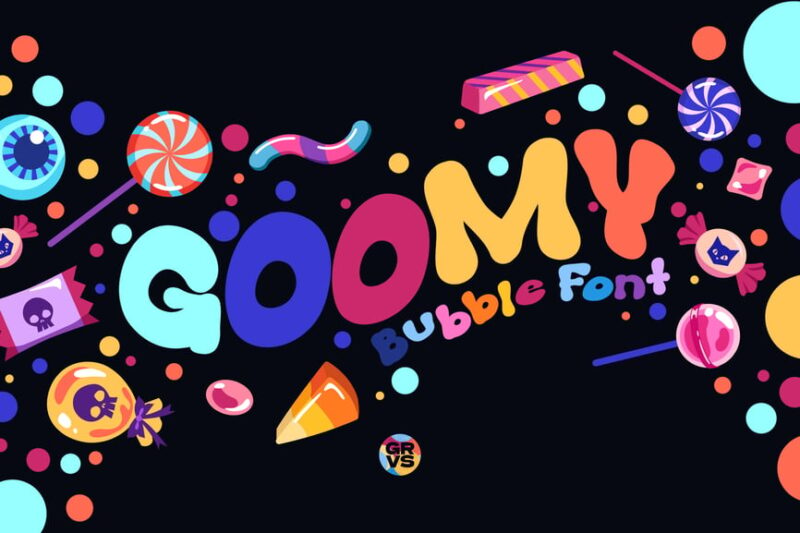
Goomy is a playful and bubbly decorative font perfect for lighthearted designs. Its rounded, inflated letterforms create a fun and whimsical atmosphere, ideal for projects related to travel, entertainment, or children’s content.
Silly Kids
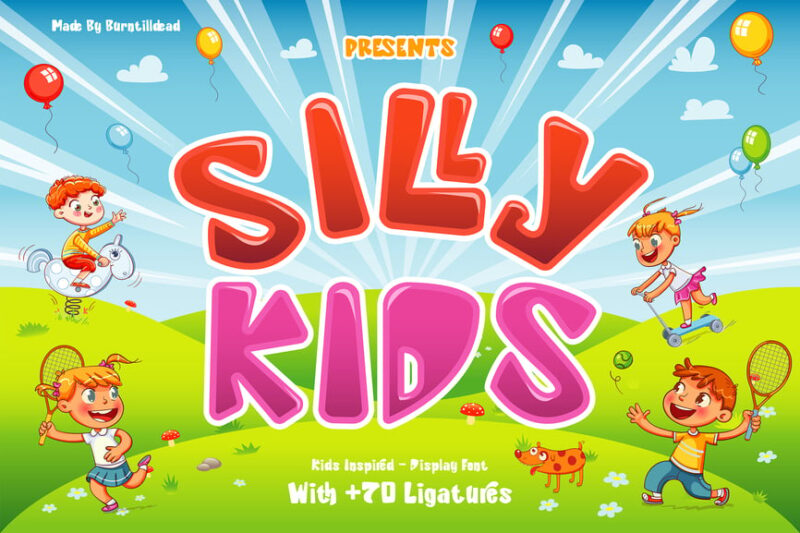
Silly Kids is a cheerful sans-serif font designed with children in mind. Its playful characters and included symbols make it perfect for kid-oriented projects, such as books, educational materials, or toy packaging.

Get 300+ Fonts for FREE
Enter your email to download our 100% free "Font Lover's Bundle". For commercial & personal use. No royalties. No fees. No attribution. 100% free to use anywhere.
Bumflup
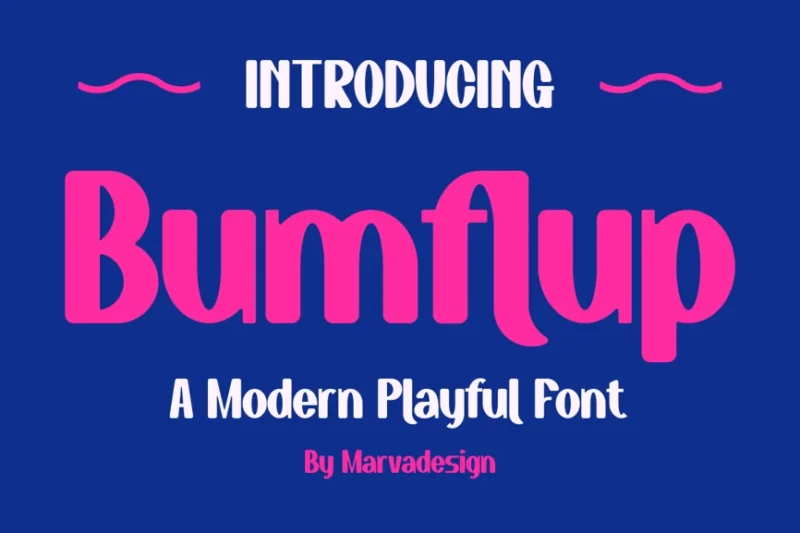
Bumflup is a modern, playful sans-serif font that exudes energy and fun. Its bold, quirky letterforms make it an excellent choice for attention-grabbing headlines, logos, or any design that needs a touch of whimsy.
Silly Creature Font
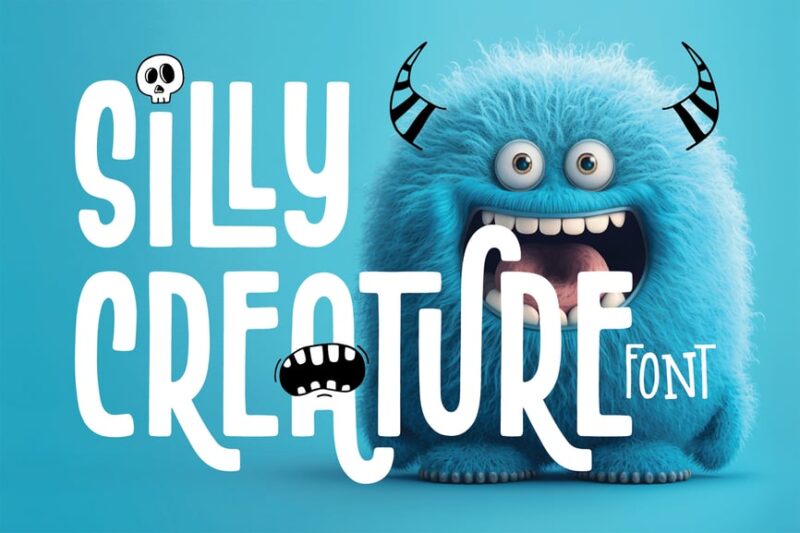
Silly Creature is a whimsical decorative monster font with a doodle-like quality. Its rounded, creature-inspired letterforms and accompanying symbols make it ideal for children’s books, cartoon-style designs, or any project requiring a touch of fantastical fun.
Drumbo
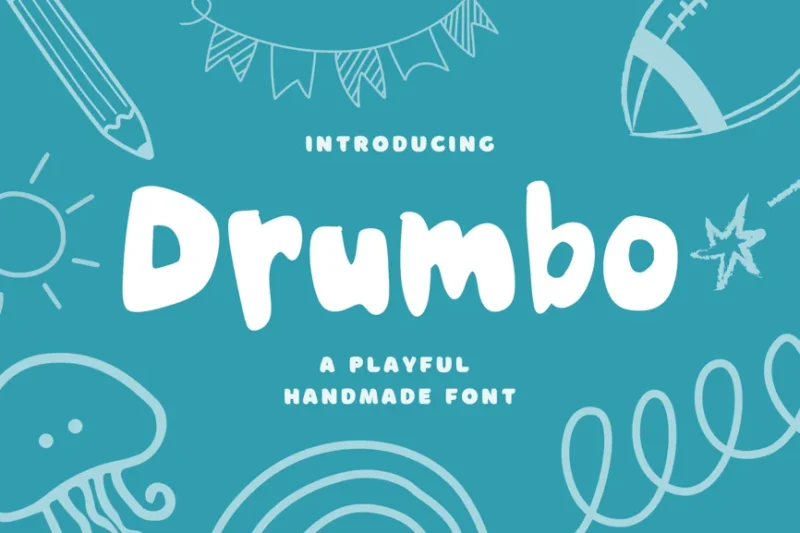
Drumbo is a playful, handmade script font that radiates fun and whimsy. Its irregular, hand-drawn style gives designs an authentic and personable touch, perfect for creative projects, invitations, or casual branding.
Quirky Form
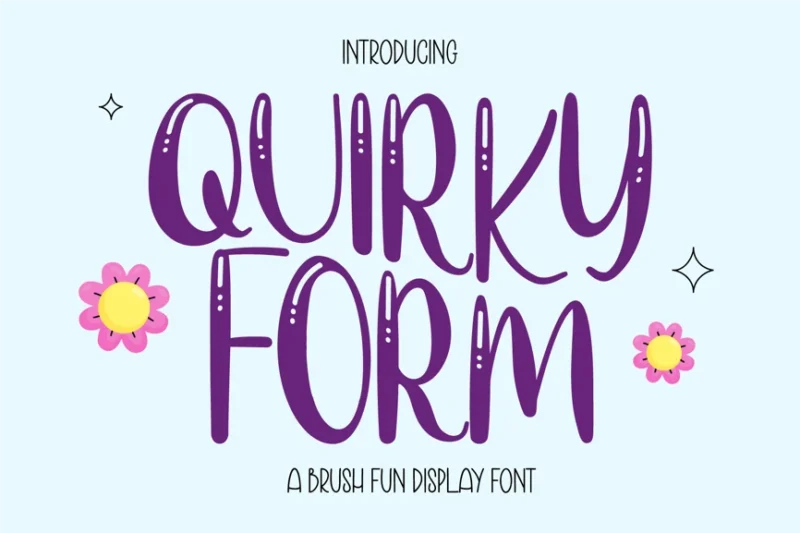
Quirky Form is a lively brush script font that embodies joy and humor. Its energetic strokes and playful character make it an excellent choice for creating eye-catching headlines, posters, or any design that aims to evoke a sense of fun.
Kartoon
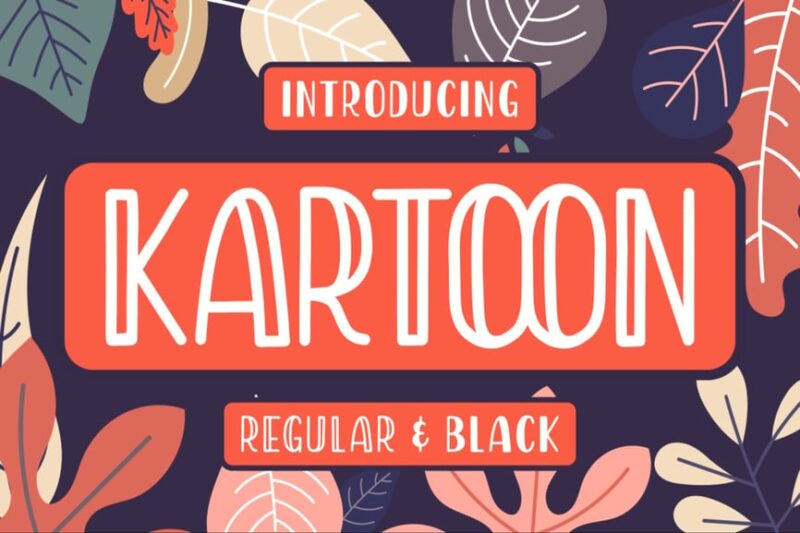
Kartoon is a playful sans-serif font with a touch of decorative flair. Its rounded edges and creative letterforms make it perfect for children’s content, cartoon-inspired designs, or any project that requires a fun and imaginative typographic approach.
Night Clown
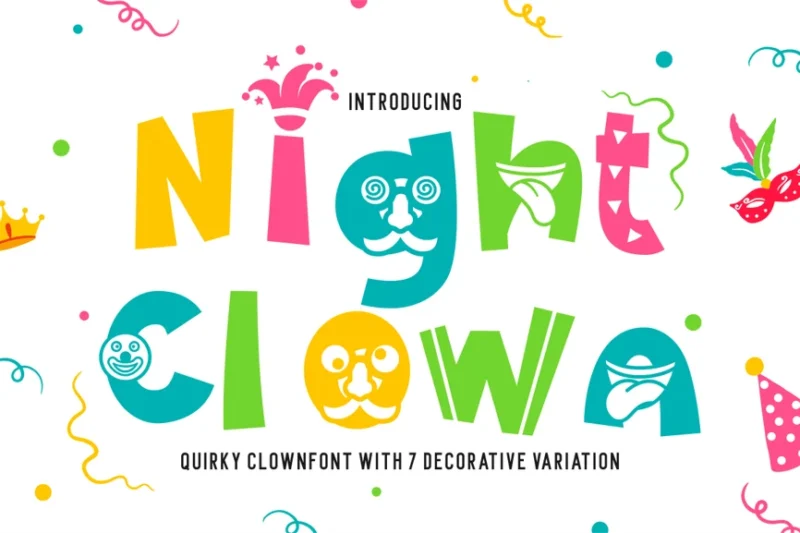
Night Clown is a quirky decorative font inspired by circus and clown aesthetics. Its playful and slightly eerie character makes it perfect for creating attention-grabbing designs for events, posters, or themed projects with a touch of whimsical darkness.
Stay Foolish
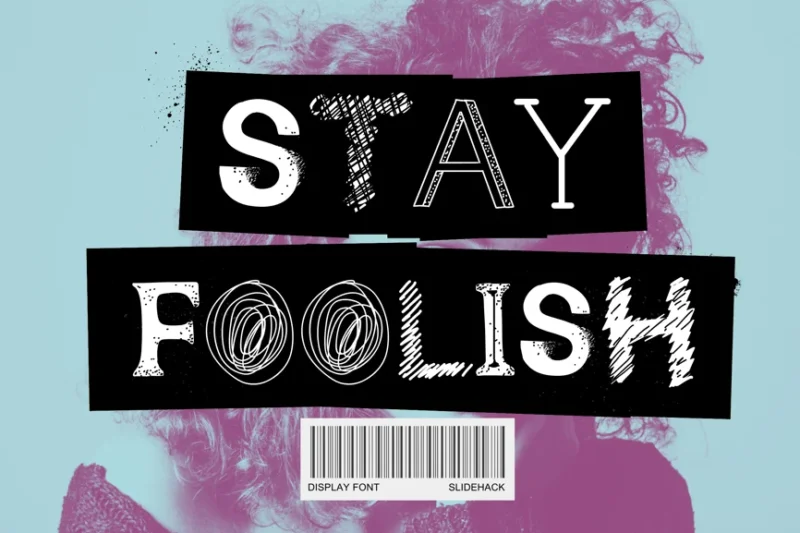
Stay Foolish is a hand-drawn display font with a doodle-like quality. Its playful, sketchy style is perfect for creating collage-inspired designs, quirky illustrations, or any project that requires a touch of creative spontaneity.
Rooly
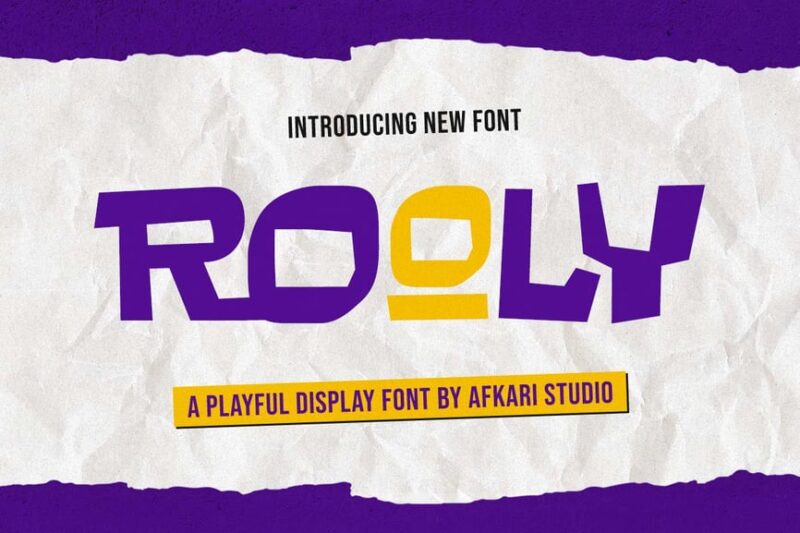
Rooly is a bold and playful display font that demands attention. Its chunky, rounded letterforms and quirky character make it ideal for creating impactful headlines, logos, or designs that need to convey a sense of fun and energy.
Happy Feet
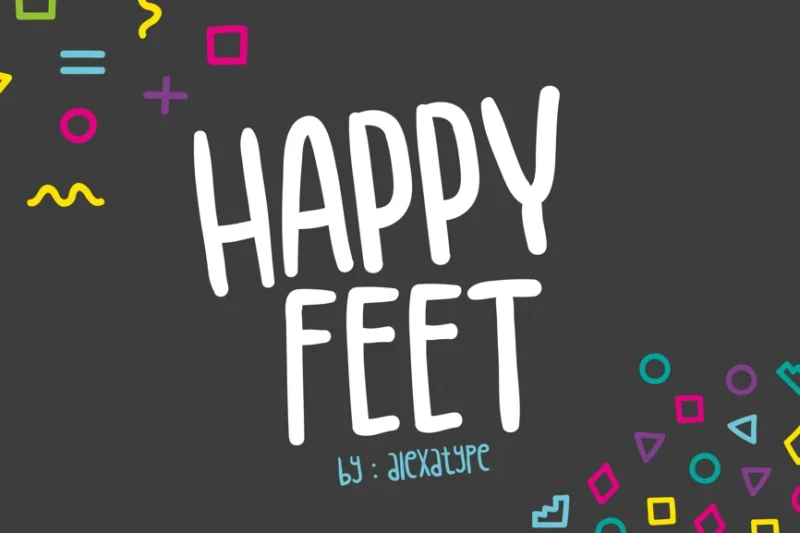
Happy Feet is a playful and whimsical decorative font that exudes joy. Its modern, bouncy character makes it perfect for creating friendly, approachable designs for children’s products, casual branding, or any project that aims to evoke a sense of happiness.
Kiti Cuties

Kiti Cuties is a rounded, cute font that combines sans-serif and script styles. Its tiki-inspired design and adorable character make it perfect for creating fun, tropical-themed designs, children’s products, or any project that requires a touch of playful exoticism.
Bunny Galore
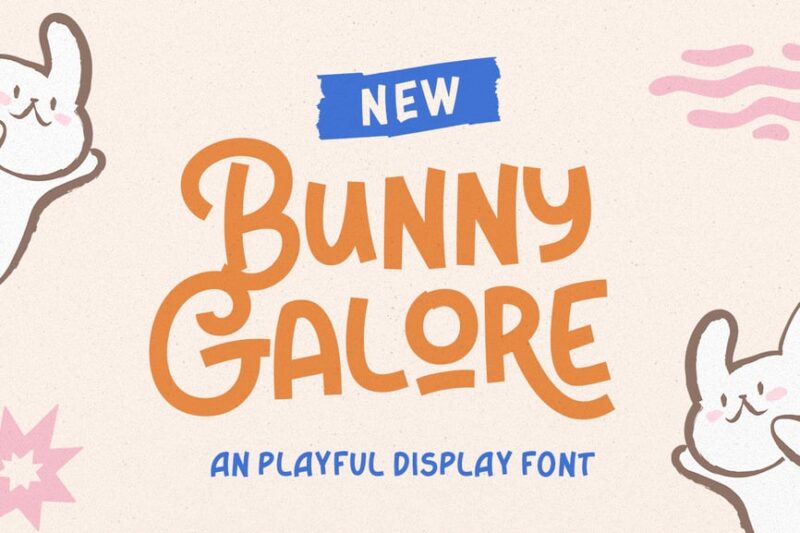
Bunny Galore is a groovy, retro-inspired decorative font. Its funky letterforms and playful character make it ideal for creating designs with a vintage 60s or 70s vibe, perfect for posters, album covers, or any project that aims to capture a nostalgic, fun atmosphere.
Jog Woiner
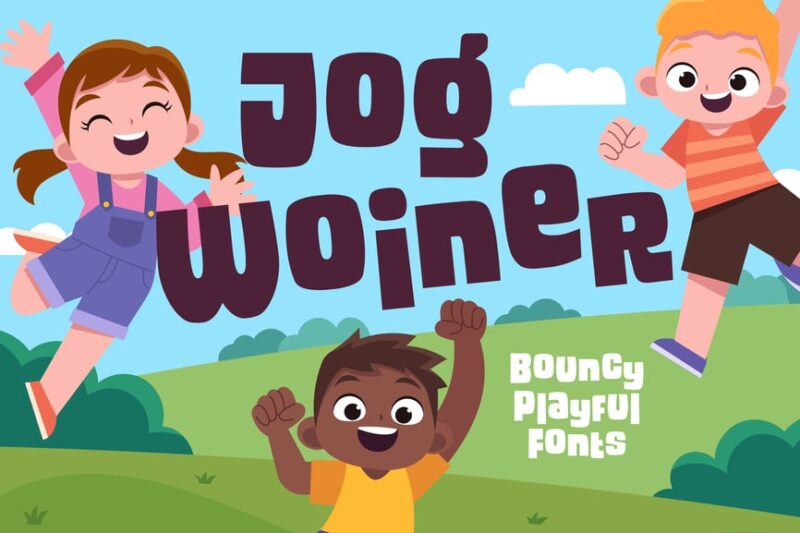
Jog Woiner is a bouncy, playful sans-serif font that adds energy to any design. Its lively character and irregular baseline create a sense of movement, making it perfect for sports-related designs, children’s products, or any project that requires a dynamic typographic approach.
Tricky

Tricky is a bubbly, fun script font that brings a touch of whimsy to designs. Its playful, hand-drawn style makes it perfect for creating friendly, approachable typography for greeting cards, packaging, or any project that aims to evoke a sense of joy and creativity.
Bloopsy

Bloopsy is a cute, modern playful sans-serif font that exudes charm. Its rounded edges and quirky character make it perfect for creating friendly, approachable designs for children’s products, casual branding, or any project that aims to convey a sense of fun and warmth.
KiddingChildren
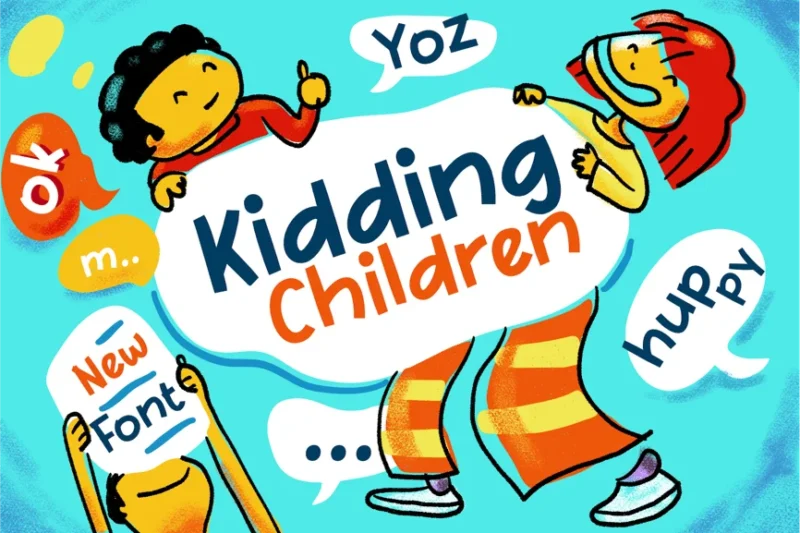
KiddingChildren is a cute font designed specifically for children’s books. Its playful mix of sans-serif and handwritten styles makes it perfect for creating engaging typography for children’s literature, educational materials, or any project aimed at young readers.
Tailor Craft

Tailor Craft is a bold, quirky display font that stands out with its unique character. Its creative letterforms and strong presence make it ideal for crafting attention-grabbing headlines, logos, or any design that requires a touch of artistic flair and originality.
Puffy Delight
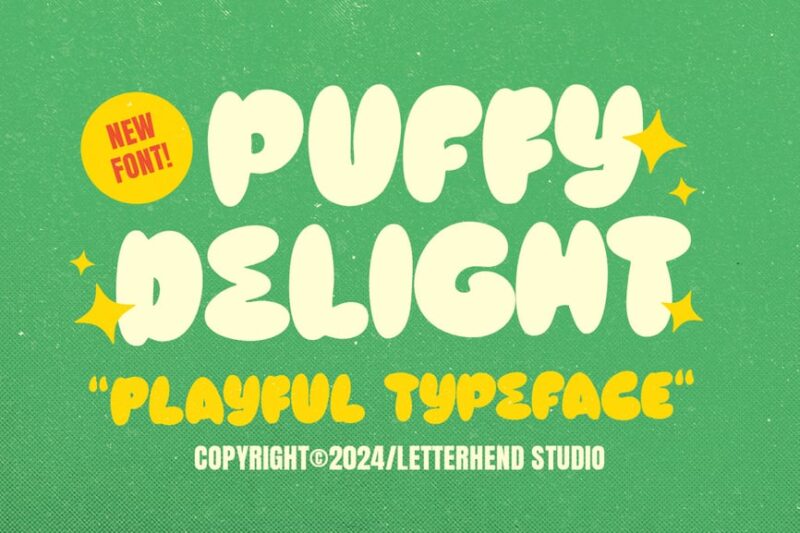
Puffy Delight is a groovy, fun decorative font that brings a retro vibe to designs. Its inflated letterforms and playful character make it perfect for creating eye-catching typography for posters, packaging, or any project that aims to evoke a sense of nostalgia and joy.
Roley Boink
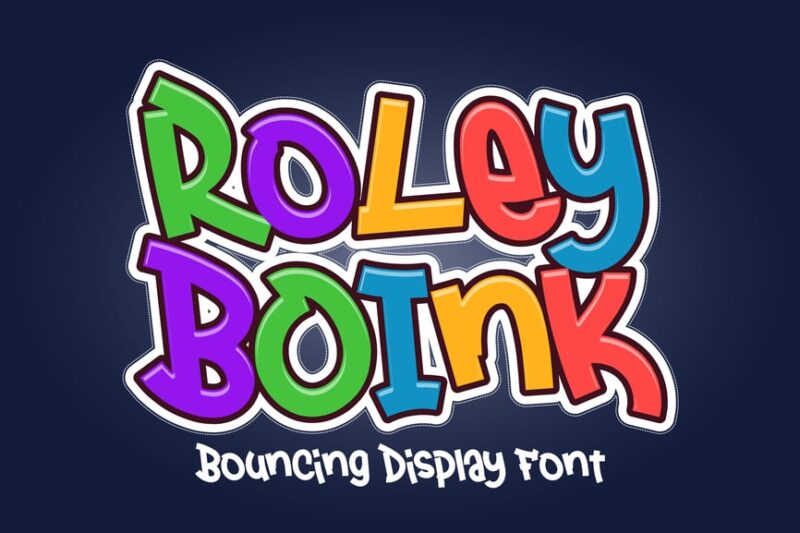
Roley Boink is a bouncing graffiti style font that adds a touch of magic and cartoonish charm to designs. Its lively character and irregular baseline create a sense of movement, making it ideal for children’s content, animated-style graphics, or any project requiring a whimsical typographic approach.
Loving Drama

Loving Drama is a playful sans-serif font that adds a touch of whimsy to designs. Its quirky letterforms and cheerful character make it perfect for creating eye-catching headlines, logos, or any project that requires a fun and energetic typographic style.
Springloved

Springloved is a playful font that combines sans-serif and decorative elements with a focus on love and weddings. Its romantic yet fun character makes it ideal for creating typography for invitations, greeting cards, or any project related to celebrations and affection.
Graham Cracker
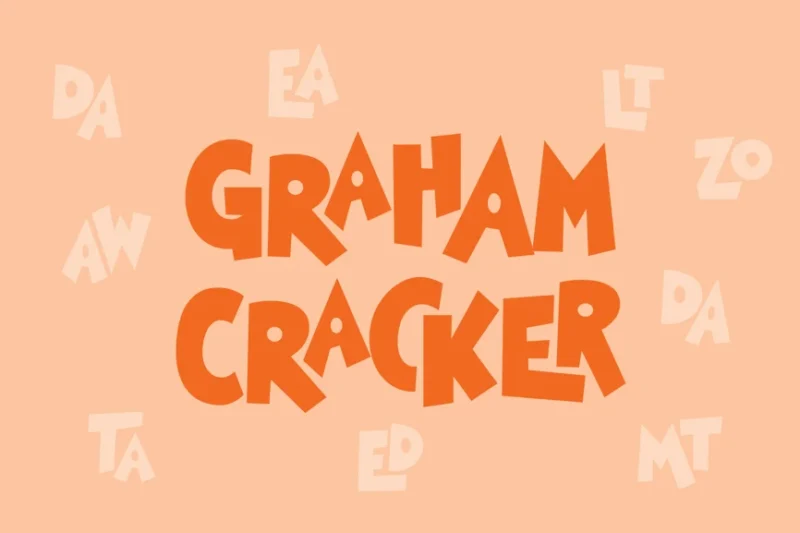
Graham Cracker is a bubbly, retro-inspired decorative font that adds a touch of nostalgia to designs. Its rounded, inflated letterforms and vintage character make it perfect for creating eye-catching typography for posters, packaging, or any project aiming for a fun, throwback vibe.
Bunny Hoops
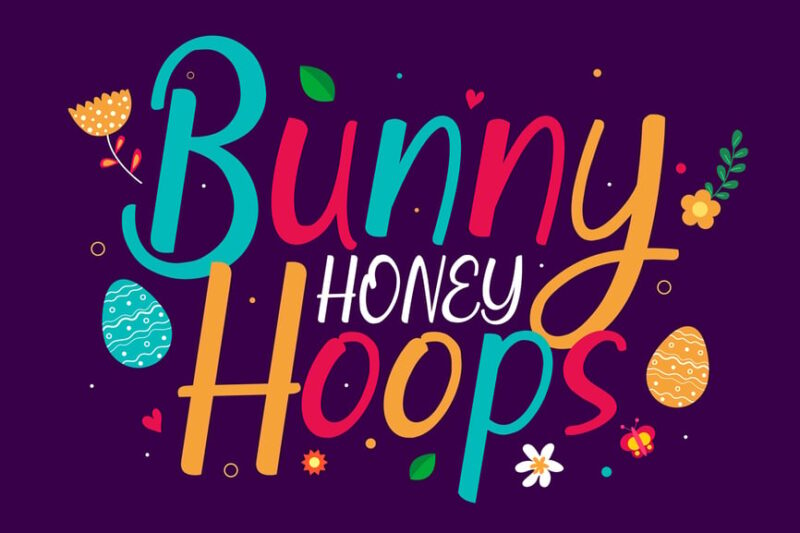
Bunny Hoops is a playful Easter-themed font with a circus-inspired twist. Its whimsical character and holiday-specific design make it ideal for creating festive typography for Easter celebrations, spring events, or any project that requires a touch of seasonal fun and excitement.
What Makes a Font Delightfully Silly?
Silly fonts get their laugh-inducing personality from several key characteristics that immediately signal “fun” to our brains:
Exaggerated Proportions
The most effective silly fonts play with proportions in unexpected ways. Think super-wide letters that look like they’ve been stretched in a funhouse mirror, or impossibly tall and skinny characters that seem to be reaching for the sky. These distorted proportions create an instant sense of playfulness because they break our expectations of “normal” letterforms.
Wobbly and Irregular Shapes
While traditional fonts pride themselves on consistency and precision, silly fonts embrace chaos. Letters that wiggle, wobble, and dance across the baseline create movement and energy. The irregularity suggests handwriting by someone who’s having way too much fun to worry about staying inside the lines.
Cartoon-Inspired Elements
Many silly fonts draw inspiration from cartoon lettering, featuring exaggerated curves, bouncy baselines, and letterforms that seem to have personalities of their own. These fonts often include playful details like stars, squiggles, or other decorative elements that add to their whimsical nature.
Unexpected Textures and Effects
Silly fonts often incorporate textures that reference familiar objects or concepts. Think fonts that look like they’re made of cheese, covered in polka dots, or dripping like melted ice cream. These textural elements create immediate visual associations that can be both amusing and memorable.
Anthropomorphic Qualities
The silliest fonts often feel like they have personalities. Letters might appear to be smiling, dancing, or even making faces. This anthropomorphic quality creates an emotional connection that makes the typography feel alive and engaging.
Where Silly Fonts Shine Brightest
Silly fonts aren’t just random acts of typographic rebellion – they serve specific purposes and work brilliantly in certain contexts:
Children’s Products and Entertainment
Kids’ brands, toys, educational materials, and entertainment venues naturally gravitate toward silly fonts. Children respond positively to playful typography that matches their sense of wonder and imagination. A silly font can make learning feel like play and transform ordinary products into magical experiences.
Party and Event Design
Birthday parties, festivals, carnivals, and other celebratory events benefit enormously from silly fonts. They set the tone for fun and help create anticipation for a good time. Whether it’s a child’s superhero birthday party or an adults-only comedy night, silly fonts communicate that serious attitudes should be left at the door.
Quirky Brand Identity
Brands that want to stand out from the crowd and show their personality often turn to silly fonts. Ice cream shops, toy stores, comedy clubs, and other businesses built around fun experiences use silly typography to differentiate themselves and create memorable brand recognition.
Social Media and Digital Content
In the fast-scrolling world of social media, silly fonts are attention-grabbers. They make posts stand out in feeds and can add personality to memes, stories, and other shareable content. The key is using them strategically to enhance your message, not overwhelm it.
Packaging Design
Product packaging that targets younger demographics or positions itself as fun and approachable often incorporates silly fonts. Think cereal boxes, candy wrappers, and novelty items where the packaging is part of the entertainment value.
When to Avoid Silly Fonts (And Why)
While silly fonts are fantastic for many applications, there are definitely times when they’re not the right choice:
Professional Business Communications
Financial institutions, law firms, medical practices, and other businesses that need to project authority and trustworthiness should generally avoid silly fonts. When someone’s money, legal rights, or health are on the line, playful typography can undermine confidence.
Serious Subject Matter
Topics like grief, tragedy, serious illness, or other sensitive subjects require respectful typography. Silly fonts can appear tone-deaf and insensitive when paired with serious content, potentially offending your audience and damaging your credibility.
Long-Form Reading
Silly fonts are typically designed for impact, not extended reading. Their exaggerated characteristics that make them fun to look at can become tiring and difficult to read over long passages of text. Save them for headlines, logos, and short bursts of text.
Cross-Cultural Communications
Humor doesn’t always translate across cultures, and what seems silly and charming in one context might be confusing or inappropriate in another. If your design will be seen by diverse international audiences, consider whether your font choice will be universally understood.
How to Choose the Perfect Silly Font
Selecting the right silly font requires balancing humor with functionality. Here’s how to make the best choice:
Match Your Audience’s Sense of Humor
Different demographics find different things funny. What makes a five-year-old giggle might not amuse a teenager, and vice versa. Consider your target audience’s age, cultural background, and preferences when selecting a silly font.
Consider the Context
A font that’s perfect for a children’s birthday party might be too playful for a family restaurant’s menu. Think about the setting where your design will appear and choose a level of silliness that fits appropriately.
Ensure Readability
No matter how funny a font is, it needs to be readable. Test your chosen font at different sizes and in various contexts to make sure your message comes through clearly. If people can’t read it, the humor is lost.
Balance with Other Elements
Silly fonts work best when they’re balanced with more subdued design elements. If everything in your design is screaming for attention, nothing stands out. Use silly fonts as accent pieces supported by cleaner, simpler typography and design elements.
The Psychology Behind Silly Typography
There’s real science behind why silly fonts work so well in certain contexts:
Emotional Priming
Silly fonts create an immediate emotional response that primes viewers for a positive experience. Before they even read your message, the playful typography signals that they’re in for something fun and lighthearted.
Memory and Recognition
Unusual and humorous elements are more memorable than conventional ones. A silly font can make your message stick in someone’s mind long after they’ve moved on, creating better brand recall and message retention.
Social Bonding
Sharing a laugh – even over something as simple as amusing typography – creates social bonds. Silly fonts can help establish a connection between your brand and your audience by showing that you don’t take yourself too seriously.
Stress Relief
In our increasingly serious world, encountering something genuinely silly can provide a moment of stress relief. Silly fonts give people permission to smile and can create positive associations with your brand or message.
Creative Alternatives to Traditional Silly Fonts
If traditional silly fonts don’t quite fit your needs, consider these creative alternatives:
Hand-Lettered Styles
Custom hand-lettering can achieve silliness through intentionally imperfect execution, playful flourishes, and personalized quirks that feel authentically human and approachable.
Modified Traditional Fonts
Sometimes you can create silliness by creatively modifying a traditional font – adding dots, changing colors, or applying effects that transform serious typography into something more playful.
Combination Typography
Mixing and matching different fonts in unexpected ways can create silly effects. Try combining a serious serif with playful script elements or using different fonts for different letters in the same word.
Illustrated Typography
Typography that incorporates illustrated elements or becomes part of a larger illustration can achieve silliness through context and visual storytelling rather than just letterform design.
Common Silly Font Questions Answered
Let’s address some frequently asked questions about silly fonts:
Are silly fonts professional?
It depends entirely on the context. Silly fonts can be perfectly professional when used appropriately for brands and messages that benefit from a playful approach. The key is matching your typography to your brand personality and audience expectations.
Can I use silly fonts for logos?
Absolutely! Many successful brands use silly or playful fonts in their logos. However, make sure the font choice aligns with your brand values and target audience. Also consider how the logo will look across different applications and sizes.
How do I know if a silly font is too silly?
Test your design with members of your target audience. If people are so distracted by the font that they miss your message, or if they react negatively to the silliness level, you might need to dial it back.
Can silly fonts work in web design?
Yes, but with considerations for loading speed, cross-browser compatibility, and accessibility. Make sure your silly font is web-safe or properly embedded, and always have fallback fonts specified.
Making Your Mark with Silly Typography
Silly fonts are powerful tools in the designer’s arsenal, capable of transforming mundane messages into memorable moments. They remind us that design doesn’t always have to be serious to be effective – sometimes the best way to connect with an audience is to make them smile.
The key to success with silly fonts lies in understanding when and how to use them. They’re not appropriate for every project, but when the context is right, they can elevate your design from forgettable to unforgettable.
Remember, the goal isn’t just to be silly for silliness’s sake. The best silly fonts serve a purpose: they enhance your message, connect with your audience, and create positive emotional associations. When used thoughtfully, silly fonts can be the secret ingredient that makes your design truly special.
So the next time you’re working on a project that could benefit from a touch of whimsy, don’t be afraid to explore the wonderfully wacky world of silly fonts. Your audience’s smiles will be worth it, and you might just find that adding a little silliness to your design toolkit opens up exciting new creative possibilities.
Whether you’re designing for kids or kids-at-heart, silly fonts prove that sometimes the most powerful design choice is the one that makes people laugh. In a world that often takes itself too seriously, silly typography reminds us that joy and professionalism aren’t mutually exclusive – they’re just different tools for different jobs.

